Sunday Dec 14, 2025
Sunday Dec 14, 2025
Tuesday, 5 September 2023 00:15 - - {{hitsCtrl.values.hits}}
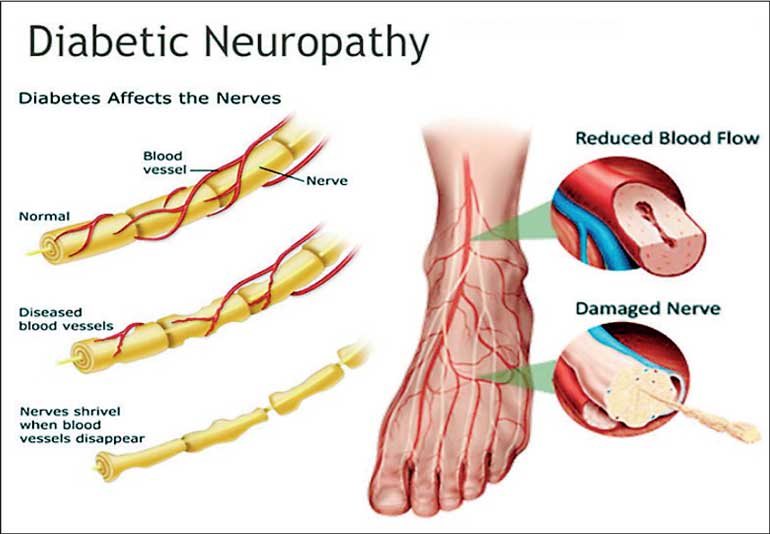
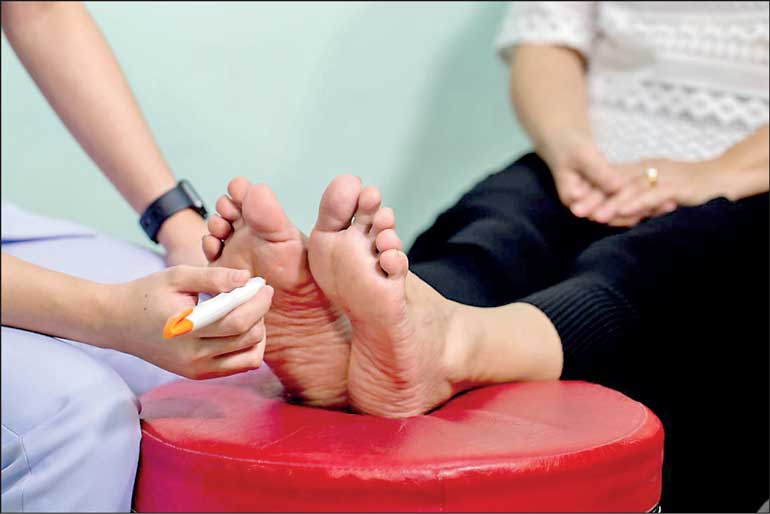

Dr. Nalaka Gunawansa
By Randima Attygalle
In an interview with the Daily FT, NHSL’s Consultant Vascular and Transplant Surgeon, Dr. Nalaka Gunawansa throws light on the importance of being mindful of high-risk feet that could 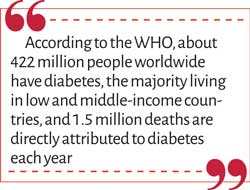 be caused by diabetes which is a multi-system disease that could even cost a limb.
be caused by diabetes which is a multi-system disease that could even cost a limb.
Sri Lanka, as a global hotspot for diabetes today, has the highest diabetes prevalence in South Asia. Diabetes is a growing cause of global mortality and morbidity and a driver of healthcare costs. The research paper titled, ‘Prevalence of diabetes and pre-diabetes in Sri Lanka: a new global hotspot- estimates from the Sri Lanka Health and Ageing Survey 2018/2019’ published in the British Medical Journal (BMJ) in February this year notes that ‘the high prevalence in Sri Lanka may be due to it being the most affluent nation in South Asia with the highest rates of overweight and obesity.’ The study confirms that adult prevalence of diabetes in Sri Lanka was 23% in 2019, and pre-diabetes was 30%, significantly higher than previous estimates suggested.
Global studies by the NCD (non-communicable diseases) Risk Factor Collaboration (NCD-RisC) and the International Diabetes Federation (IDF) indicate that diabetes in low and middle-income countries is increasing faster than in high-income countries, with age-standardised prevalence in most developing regions being higher than high-income countries. According to the WHO, about 422 million people worldwide have diabetes, the majority living in low and middle-income countries, and 1.5 million deaths are directly attributed to diabetes each year.
Loss of sensation
Diabetes, as Consultant Vascular and Transplant Surgeon at the National Hospital of Sri Lanka (NHSL) Dr. Nalaka Gunawansa explains, is no longer a condition where a person could simply control blood sugar and walk away from the clinic. “Today it is a multi-system disease which requires a collective approach with multiple specialists coming into play, offering a composite plan.” Diabetes is a major cause of blindness, kidney failure, heart attack, stroke and lower limb amputation.
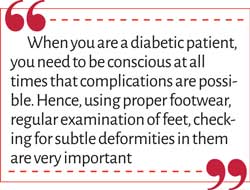 Long standing diabetes causes damage to the nervous system, resulting in loss of sensation, a condition known as ‘diabetic neuropathy’. “The natural warning mechanism we have when there is an injury in our legs or feet is pain. However, people with diabetic neuropathy are less likely to notice the presence or the gravity of a wound on their feet as they lack this pain sensation. This inability to feel pain could backfire because they would be blissfully unaware of the wounds or ulcers until they become severe,” explains Dr. Gunawansa. The infection, he says, could “spread like wildfire” resulting in tissue death and even an amputation at the level of the knee. “In such a situation, an amputation has to be done more as a life-saving measure than anything else.” Furthermore, he says, diabetes could result in poor blood circulation in the legs. This can add insult to injury as the wound healing is further impaired and allows the rapid progression of infection.
Long standing diabetes causes damage to the nervous system, resulting in loss of sensation, a condition known as ‘diabetic neuropathy’. “The natural warning mechanism we have when there is an injury in our legs or feet is pain. However, people with diabetic neuropathy are less likely to notice the presence or the gravity of a wound on their feet as they lack this pain sensation. This inability to feel pain could backfire because they would be blissfully unaware of the wounds or ulcers until they become severe,” explains Dr. Gunawansa. The infection, he says, could “spread like wildfire” resulting in tissue death and even an amputation at the level of the knee. “In such a situation, an amputation has to be done more as a life-saving measure than anything else.” Furthermore, he says, diabetes could result in poor blood circulation in the legs. This can add insult to injury as the wound healing is further impaired and allows the rapid progression of infection.
Transcending social standing
Although people with diabetes have an increased risk of the loss of a limb or an amputation, it is possible to help prevent most diabetes-related amputations by managing blood sugar levels, wearing suitable footwear, and taking good care of the feet, notes the Vascular Surgeon. Even though the rural Sri Lankan community is more susceptible to foot injuries, (given the 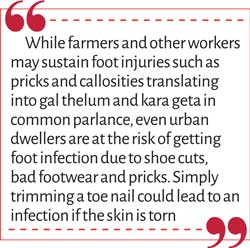 fact they walk barefoot), diabetes-induced foot ulcers are now presented by those in urban settings, including professionals as well. While farmers and other workers may sustain foot injuries such as pricks and callosities translating into gal thelum and kara geta in common parlance, even urban dwellers are at the risk of getting foot infection due to shoe cuts, bad footwear and pricks. Simply trimming a toe nail could lead to an infection if the skin is torn. “As a clinical practitioner in Colombo, I see a good number of patients with what we call ‘high risk feet’ in the city who have sustained foot injuries and subtle deformities due to neuropathy. Therefore, it is no longer confined to farmers or workers,” points out Dr. Gunawansa.
fact they walk barefoot), diabetes-induced foot ulcers are now presented by those in urban settings, including professionals as well. While farmers and other workers may sustain foot injuries such as pricks and callosities translating into gal thelum and kara geta in common parlance, even urban dwellers are at the risk of getting foot infection due to shoe cuts, bad footwear and pricks. Simply trimming a toe nail could lead to an infection if the skin is torn. “As a clinical practitioner in Colombo, I see a good number of patients with what we call ‘high risk feet’ in the city who have sustained foot injuries and subtle deformities due to neuropathy. Therefore, it is no longer confined to farmers or workers,” points out Dr. Gunawansa.
Foot-deformities
Apart from neuropathy which results in lack of pain and sensations that alert a person to seek care, many other changes could occur in the legs and feet of a diabetic. “When diabetes is long-standing there are subtle deformities occurring in the feet; they happen over a period of time, so much so, people don’t realise that there is a deformity because the change is gradual. Flat-foot, Charcot foot, hammer toes and claw toes are some of the deformities.” An experienced clinician however, could diagnose these minor deformities at its early stage, Dr. Gunawansa says. Such deformities per se could cause wounds as different parts of the foot would experience more friction and pressure when walking or standing, he adds. Some diabetic patients could have a poor blood supply to their legs where blood vessels get blocked. This condition known as ‘peripheral vascular disease’ is another complication of diabetes which manifests on the feet and legs. “Coupled with the fact that they now have deformed feet which predispose them to wounds, plus the neuropathy which prevents them from getting the normal warning mechanism, when they get a wound on top of it, the situation would become quite complicated,” warns the Surgeon. Due to insufficient blood supply, such wounds would not heal easily, and when the condition escalates it would eventually result in the death of a tissue.”
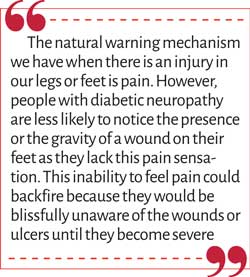 With the onset of adolescent diabetes on the rise, the complications of mismanaged diabetes including ulcers are more likely to occur very early, the Consultant says. “While such complications may occur mostly in diabetic patients who are in their 60s and 70s, they may develop as early as 30s and 40s in those who are diagnosed with diabetes in their adolescence.”
With the onset of adolescent diabetes on the rise, the complications of mismanaged diabetes including ulcers are more likely to occur very early, the Consultant says. “While such complications may occur mostly in diabetic patients who are in their 60s and 70s, they may develop as early as 30s and 40s in those who are diagnosed with diabetes in their adolescence.”
Expansion of diabetic care
With the availability of vascular surgeons across the island and diabetic care branching out, we are still “not on the top of the problem,” reflects Dr Gunawansa. “As surgeons we are doing a lot to increase awareness of mismanaged diabetes at regional level. With endocrinologists getting the message of early diagnosis across, more patients are referred for treatment earlier than before, yet the issue remains grave and serious.” Today, specialised diabetic and vascular clinics have expanded so that more patients could access diabetic care. “Unlike ten years ago when vascular surgeons were available only in Colombo and Kandy, today we find them in every province in the country. The clinical interventions have also expanded to detect complications earlier than we used to and we are able to salvage limbs more often than before,” says Dr. Gunawansa, adding that people still need to be more mindful of diabetes management.
Apart from managing blood sugar levels, the peripheral concerns of a diabetic patient are crucial in avoiding complications in conditions such as the loss of a limb, the Consultant said. “When you are a diabetic patient, you need to be conscious at all times that complications are possible. Hence, using proper footwear, regular examination of feet, checking for subtle deformities in them are very important.” It is important that diabetic patients seek proper clinical care. “Those with high-risk feet should ideally be examined by a qualified surgeon, so that referrals to clinics, cleaning of wounds if any and other foot care related advice could be professionally given,” Dr Gunawansa notes.
Economic burden
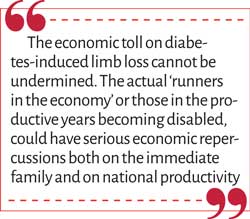 The economic toll on diabetes-induced limb loss cannot be undermined. The actual ‘runners in the economy’ or those in the productive years becoming disabled, could have serious economic repercussions both on the immediate family and on national productivity. “We come across many bread winners unable to go to work for months because of their high-risk feet. Worse still, in case of an amputation, with a prosthetic leg, they cannot perform the same chores they did earlier. As a result, an entire family would be at a loss. The impact that diabetic-disability has on the health budget of a country too cannot be undermined; repeated treatments, cost of drugs and hospital care could be quite significant. Even if a patient seeks treatment in the private sector, the toll it takes on the family is huge, impacting the quality of life in the long run,” concludes Dr. Gunawansa.
The economic toll on diabetes-induced limb loss cannot be undermined. The actual ‘runners in the economy’ or those in the productive years becoming disabled, could have serious economic repercussions both on the immediate family and on national productivity. “We come across many bread winners unable to go to work for months because of their high-risk feet. Worse still, in case of an amputation, with a prosthetic leg, they cannot perform the same chores they did earlier. As a result, an entire family would be at a loss. The impact that diabetic-disability has on the health budget of a country too cannot be undermined; repeated treatments, cost of drugs and hospital care could be quite significant. Even if a patient seeks treatment in the private sector, the toll it takes on the family is huge, impacting the quality of life in the long run,” concludes Dr. Gunawansa.